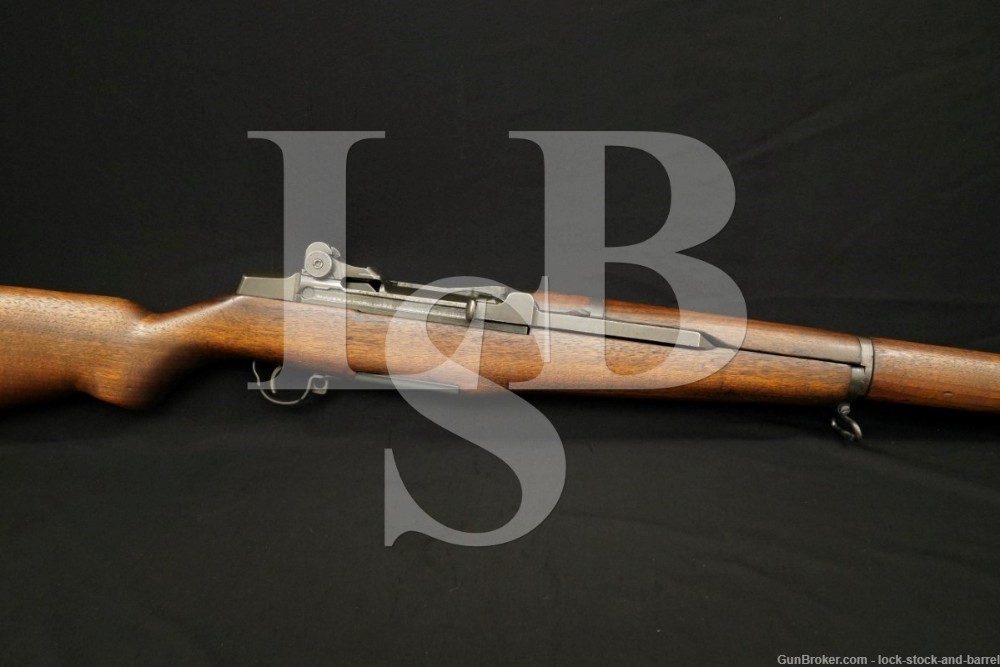
US Springfield M-1 M1 Garand Matching .30-06 Semi Automatic Rifle, 1955 C&R
SOLD FOR: $1575
LSB#: 211002NI84
Make: Springfield Armory
Model: M1 Garand
Serial Number: 5870457
Year of Manufacture: 1955 – 1957. Barrel Date: May, 1955
Caliber: .30-06 Springfield
Action Type: Semi Auto, En Bloc Clip Fed
Markings: There is no import mark.
Receiver: “U.S. RIFLE / CAL. .30 M1 / SPRINGFIELD / ARMORY / 5870457”
Trigger Group: “6528290-SA”- Correct for the Springfield serial number (page 90 of Joe Poyer’s M1 GARAND 1936 to 1957, 6th Edition).
Hammer: “SA 5546008”– Correct for the Springfield serial number (page 98).
Safety: “SA-11” – Correct for the Springfield serial number (page 104).
Follower: Unmarked – Correct for the Springfield serial number (page 83).
Receiver Leg: “T4”, and “F 6528291” – Correct for the Springfield serial number (page 756 of Bruce Canfield’s book, The M1 Garand Rifle).
Op Rod: “6535382 SA” – Correct for the Springfield serial number (page 71).
Barrel: “T”, “P” (3 times), and “SA F6535448 5 55 MD 50” – Correct date range for the Springfield serial number (page 63 – 64).
Bolt: “6528287-SA / A15” – Correct for the Springfield serial number (page 53).
Gas Cylinder Lock Screw: “P O” – A Springfield subcontractor part (page 115).
The stock and sights are described below.
Barrel Length: Approximately 24 Inches
Sights / Optics: The front sight is a blade set between two protective wings. The rear sight is a fully adjustable aperture sight set between two protective wings.The windage knob is marked “LEFT arrow” twice and “DRC”. The elevation knob is marked from “2-12” in increments of two and “NI C”.
Stock Configuration & Condition: The left side of the stock is stamped with a faded Defense “Eagle” acceptance stamp above the trigger. The face of the grip is marked with a “circled P” proof.
The hardwood stock has a pistol grip, metal nose caps, a stacking loop, two sling loops, and a metal buttplate with hinged door for storage in the butt. The buttplate shows scrapes, small scratches, and oxidation. The stock shows several scrapes, scratches, and compression marks. Many have damaged small portions of the surface wood. These marks have been oiled. The LOP measures 13 inches from the front of the trigger to the back of the buttplate. The stock rates in about Very Good Plus overall condition.
Type of Finish: Parkerized
Finish Originality: Original. The front of the barrel and bottom of the trigger group have been coated with paint.
Bore Condition: The muzzle & grooves are gray and the rifling is deep. There is fouling and intermittent erosion in the grooves. The fouling should clean up some. The bore shows an M.E. of 1.5. The throat shows a T.E. of 3.
Overall Condition: This rifle retains about 90% of its metal finish. The front of the barrel and bottom of the trigger group have been coated with paint. The metal shows light scrapes, small scratches, and light thinning on the leading edges of the metal. The receiver shows a freckling of oxidation. The receiver legs and underside of the receiver show areas of thinning. The right side of the receiver and the front of the bolt show some thinning consistent with cycling. Most of the markings are deep. Overall, this rifle rates in about Very Good condition.
Mechanics: The action functions correctly. We did not fire this rifle. As with all used firearms, a thorough cleaning may be necessary to meet your maintenance requirements.
Box, Paperwork & Accessories: None
Our Assessment: The U.S. Rifle, Caliber .30, M1 is known affectionately as “the Garand” after its inventor, John Garand. The rifle would become the first standard-issue semi-automatic infantry rifle in the world. While some countries entered the war with limited issued semi-automatic rifles or developed such rifles during the war, America was the only nation to enter with its Army issuing autoloading rifles on a large scale. General Patton famously referred to the rifle as “the greatest battle implement ever devised”. Millions were produced during WWII and hundreds of thousands afterward, seeing use through the Korean War and into the Vietnam War. Interestingly, while many other weapons and military items would see production contracts sent out to otherwise non-related companies, during WWII production remained with Springfield Armory and Winchester. It was only after WWII that production would be contracted out to another gunmaker, Harrington & Richardson, as well as the agricultural equipment maker, International Harvester.
This Springfield Armory M1 Garand was made back in 1955. It is a “matching” M1 Garand that uses parts with markings and/or drawing numbers that are correct for the rifle’s serial number. Matching M1 Garands are hard to find and quite the collectors item. This Matching Springfield M1 Garand looks good and should be a blast out at the range. Good luck.

